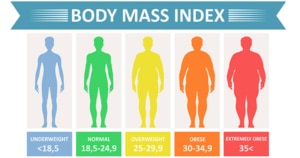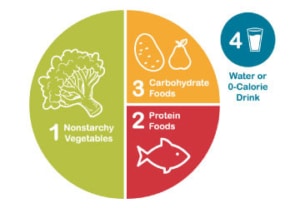It’s time to learn about the factors and relationship between weight and diabetes that may be standing between a person living with diabetes and a healthier weight. In this piece, we will talk about why weight matters when managing diabetes.
What is the link between type 2 diabetes and body weight?
Diabetes and obesity are closely related. Excess body weight should be taken seriously and is just one risk factor for type 2 diabetes, along with your family history, diet, physical activity level and more.
According to the American Society for Metabolic and Bariatric Surgery, more than 90 percent of people with type 2 diabetes are overweight or have obesity.
While it is true that obesity can lead to diabetes, it is important to understand the link between insulin and weight. Insulin plays a role in regulating blood sugar levels and converting food energy into fat. It also helps break down fats and proteins. During digestion, insulin stimulates muscle, fat, and liver cells to absorb glucose. The cells either use this glucose for energy or convert it into fat for long-term storage. Eating more calories than the body needs will lead to excess glucose levels. If the cells do not remove glucose from the blood, the body will store it in the tissues as fat resulting in weight gain.

Understanding insulin resistance
The American Diabetes Association explains that people with insulin resistance, also known as impaired insulin sensitivity, have a built up a tolerance to insulin, making the hormone less effective. As a result, more insulin is needed to persuade fat and muscle cells to take up glucose and the liver to continue to store it.
The problem is that When you have type 2 diabetes, your body isn’t as receptive to insulin as it once was. This means that the insulin can’t filter out the glucose in your blood. Our bodies respond by making more insulin to combat this. Insulin also works to promote fat storage and block the release of fat from fat storage. So instead of losing weight, you keep gaining, thanks to all that insulin. The American Diabetes Association continues to explain that this is why people with type 2 diabetes tend to have elevated levels of circulating insulin. Over time, insulin resistance can get worse, and the pancreatic beta cells that make insulin can wear out. Eventually, the pancreas no longer produces enough insulin to overcome the cells’ resistance. The result is higher blood sugar levels, and ultimately prediabetes or type 2 diabetes.
Now if a person is identified as being pre-diabetic, the first thing their physician will recommend is weight loss to assist the body in absorbing insulin and lower the chances of developing type 2 diabetes. If you are already diagnosed with type 2 diabetes, you’re likely to hear the same thing: lose weight and change your lifestyle to stay healthy! To reduce the risk of weight gain with diabetes, it is important to manage glucose levels through a healthy diet and exercise.
Can losing weight reverse a type 2 diabetes diagnosis?
While T2D (type 2 diabetes) is incurable, it is possible to manage the disease through lifestyle changes, including (you guessed it) losing weight! By following a healthy diet, food portion control, and with increased physical activity you can manage diabetes. Also, taking steps to lose weight will move individuals living with type 2 diabetes in a positive direction.
How to stay at a healthy weight when you have diabetes.
When trying to maintain a healthy weight, there are a few simple things that you can do to help.
Eat well
- It is important that people with diabetes keep track of how many calories they are consuming and which foods they are eating daily.
- Never cut calories by skipping meals.
- For variety, try to find fun and healthy alternatives for your everyday meals by using recipe websites online.
- Try to stay away from refined carbohydrates. It can feel like there’s nothing better than a big bowl of pasta or warm garlic bread, but these are sure fire ways to mess up your blood sugar. Try whole grains like brown rice and quinoa instead. Focus on whole foods instead of highly processed foods. Also, keeping track of how many carbohydrates you eat and setting a limit for each meal can help keep your blood sugar levels in your target range. Work with your doctor or a registered dietitian to find out how many carbs you can eat each day and at each meal.
Watch your weight and waist size
- Measure your weight and waist size. This way, you can make notes of changes and know if your diet and lifestyle are working out positively.
- Remember, a healthy waist circumference depends on gender. The recommendations are:
- less than 80cm (31.5 in) for all women
- less than 94cm (37 in) for most men
Plan ahead
- If you plan your meals, workouts, and weigh-ins ahead of time, it is far less likely for you to slip up.
- Make a schedule or a calendar so that you can see progress from week to week. This can help motivate you to continue to reach your goals.
- When daily obstacles occur in your planning, think about backup meal plans for example if you work late and don’t have time to make dinner when you get home.

Exercise!
- Physical activity can not only help you lose weight but also make you feel better.
- This can be one of the hardest things to start, so starting slow is ok. Just make sure that you are showing improvement each week.
- Try to switch up the activities you do so that you do not get bored of one thing. It can make it easier to continue working out long term. A daily walk is a great way to start, but then you can mix in low impact activities like swimming, yoga, dancing, or Pilates.
What is considered a healthy weight?
Obesity is when you carry excess body fat. It involves both the size and amount of fat cells. Defined by the National Institutes of Health (NIH), “Obesity is considered a BMI of 30 or above”. Morbid obesity is over 40. BMI (body mass index) is “weight in kilograms divided by height in meters squared”. When looking at what a healthy weight is for a person with diabetes, let’s look at the figures from the CDC, based on the BMI Index Chart.

Input versus Output
If the calories you eat are roughly equal to the calories you burn, then theoretically, you will stay about the same weight. When caloric intake exceeds the body’s requirements, excess calories are stored as fat.
One pound of body fat stores roughly 3,500 calories! Ouch! Getting rid of one pound of body fat requires using 3,500 calories out of storage. That won’t happen in a day. Weight takes time to put on and takes time to take off. A caloric deficit of 500 calories per day can mean losing one pound per week. To achieve this, it’s best to combine caloric restriction with increased energy expenditure through regular exercise. A suggested rate of weight loss is 1-2 pounds per week. Health benefits can be realized with even modest amounts of weight loss.
Small dietary changes can make a difference over time. Giving up 150 calories per day saves you 54,750 calories per year! (150 calories is the number of calories in either 1-ounce of regular potato chips or 12 ounces of regular soda.) When cutting back on calories, be sure to eat a varied and well-balanced diet. You still need the recommended amount of vitamins and minerals.
The Plate Method

It’s easy to eat more food than you need without realizing it. The plate method is a simple, visual way to make sure you get enough non-starchy vegetables and lean protein while limiting the amount of higher-carbohydrate foods you eat that have the highest impact on your blood sugar.
Even a modest weight loss of 5 to 10 percent of your total body weight is likely to produce health benefits, such as improvements in blood pressure, blood cholesterol, and blood sugars.
Behavior Change Tips
- Create a strategy for making a change.
- Predict challenges and devise a plan to overcome them.
- Act on your plan.
- Get support, if needed.
- Evaluate your progress.
- Don’t get discouraged, and don’t give up! Stay positive.
- Refine your plan or make changes to your plan as needed.
Kicking Off the Healthy T2D Lifestyle
We hope this piece gave you some concrete tips to get started! Remember starting small is fine and that little every day changes can lead to big results in your type 2 diabetes management. Don’t forget that you can always work with Advanced Diabetes Supply for all of your diabetes testing needs. We are here to help!
